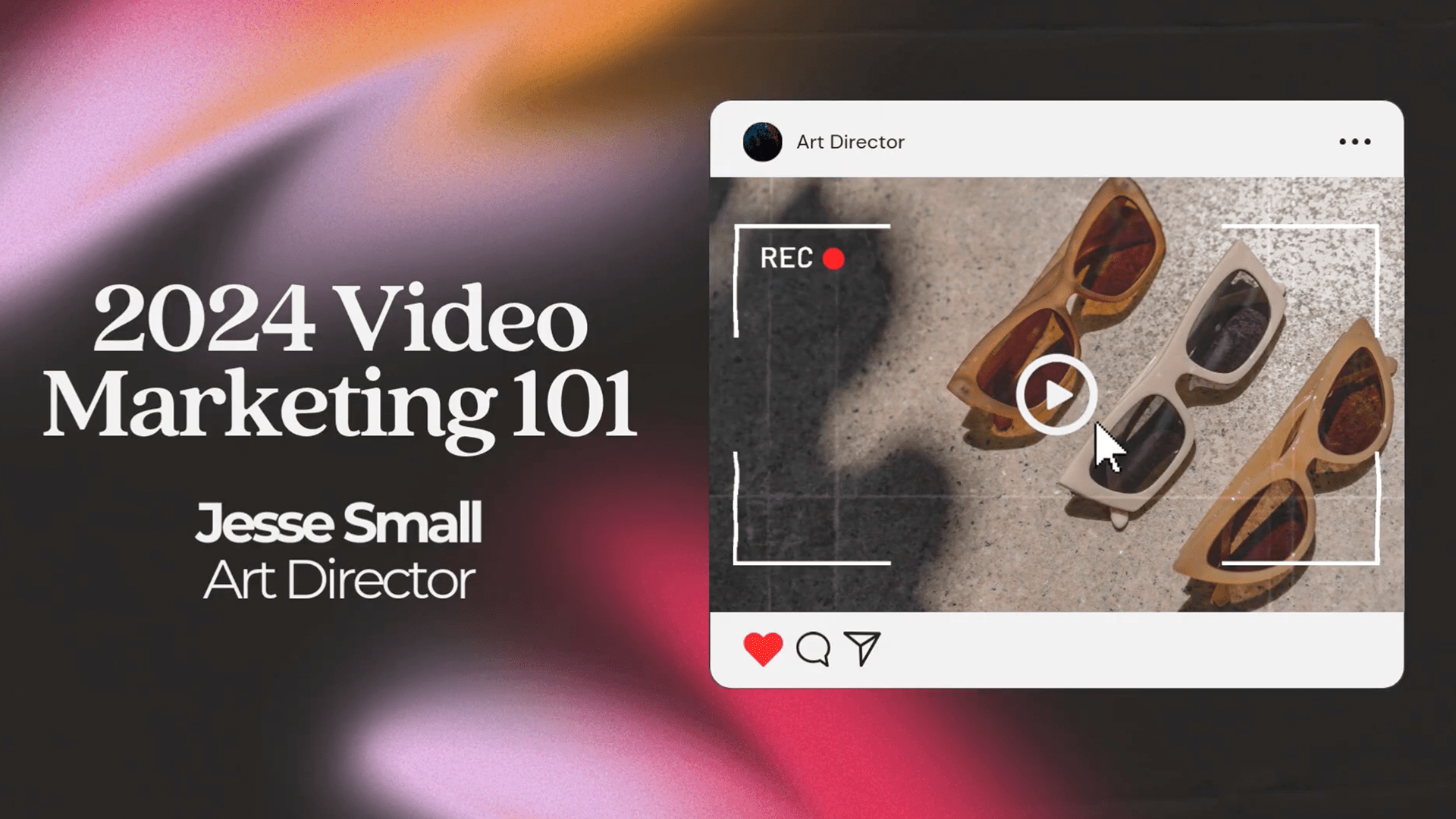
In today’s digital age, video marketing is no longer a trend—it’s an essential tool for businesses looking to connect with their audience, boost brand awareness, and drive sales. Looking into 2024, the world of video marketing is more dynamic than ever, offering new opportunities and challenges for marketers. Whether you’re just starting out or looking to fine-tune your strategy, use this guide to video marketing to help you navigate this important marketing medium.
We all love watching videos. For many of us, it’s ingrained in our daily lives one way or the other. They’re engaging, memorable, and often more fun than reading text or looking at images. Nearly all marketers (96%, according to Wyzowl’s marketing statistics) consider video content marketing an essential part of their marketing strategy, and 91% of businesses use video as a marketing tool.
But what is it? And why is video marketing so effective? For starters, videos capture and hold attention longer than other types of content. They also convert better—studies show that having a video on your landing page can boost conversions by up to 80%. Plus, videos are great for SEO. Search engines love diverse content, and videos can help improve your rankings. And let’s not forget brand recall—people are more likely to remember your brand after watching a video than after reading a blog post or looking at an image. In its most basic definition, video marketing is a marketing strategy that uses video content to promote products, services, or a brand.
In order to grasp the importance of video marketing, we need to get a fuller picture of what makes the foundation of video marketing so effective.
Video content is more engaging and memorable than text or images alone. According to recent statistics, video content is expected to account for over 82% of all internet traffic by the end of 2024. This trend highlights the increased preference for video content among consumers, making it a critical piece of any marketing strategy.
Here are a few reasons why video marketing is effective:
Leveraging video content marketing in a strategic and effective manner can result in a multitude of benefits for your business. This dynamic approach not only captivates your audience but also drives engagement, enhances brand visibility, and boosts conversion rates.

Video marketing is a great way to grab people’s attention and keep them interested. Videos are naturally engaging and can explain things in a quick and concise manner. Whether you’re telling a story, showing off a product, or teaching something new, videos make it easier for people to understand and remember your message.
Another benefit is that videos can help boost your sales. When people see a product in action or hear real customer stories, they’re more likely to trust your brand and make a purchase. In addition, videos are easy to share on social media, which can help your content cast a wider net and reach a bigger audience. The website ranks higher on search engines, bringing more visitors to your site. Video marketing is a powerful tool that can help you connect with your audience, build trust, and grow your business. It offers an abundance of benefits that go beyond traditional marketing methods.
One of the primary advantages is enhanced audience engagement. Videos are inherently more engaging than text or static images because they combine visuals, sound, and storytelling elements. This multifaceted approach captures viewers’ attention more effectively, keeps them interested for longer periods, and ultimately leads to higher levels of engagement. It could be anything from a product demo, a behind-the-scenes look at your company, or customer testimonials—videos provide an immersive experience that can connect with audiences on a deeper emotional level.
Another significant benefit of video marketing for brands to note is its ability to boost conversion rates. Studies have consistently shown that including a video on a landing page can increase conversions by up to 80%. Videos help potential customers better understand your products or services, making them more likely to make that purchase. They also provide a compelling way to highlight key features and benefits, demonstrate product usage, and showcase customer success stories. By reducing uncertainties and answering potential questions upfront, videos help move prospects down the sales funnel more efficiently.
One of the video marketing tips to keep in mind is how this tactic can play a crucial role in improving search engine optimization (SEO). Search engines like Google prioritize websites with diverse content, including videos, because they tend to engage users more effectively. Videos increase the time users spend on your site, which is a positive signal to search engines. Moreover, well-optimized videos with relevant keywords in titles, descriptions, and tags can significantly boost your visibility in search results. Additionally, videos are highly shareable, and creating content that people want to share on social media can drive significant organic traffic to your site.
Finally, video marketing enhances brand recall and builds trust with your audience. People are more likely to remember information presented in a video compared to text. A compelling video can leave a more lasting impression and help reinforce your brand message. Videos allow brands to show authenticity and transparency, which can build trust with viewers. Seeing the faces behind a brand, understanding its mission, and watching real customers share their experiences can create a sense of loyalty among your audience. In an era where consumer trust is paramount, video marketing offers an invaluable way to build and maintain strong customer relationships.
As we continue to think through the benefits of video marketing, we’ve compiled a shortlist of some of our favorite examples of how video marketing was used to enhance brands and their messaging.
Nike has long been a leader in leveraging video to tell powerful stories. Their “Just Do It” campaign is iconic, and they continue to push boundaries with inspirational content. In 2024, Nike has taken storytelling to new heights with a series of videos featuring athletes from diverse backgrounds overcoming personal and professional challenges. These videos aren’t just about selling shoes—they’re about inspiring viewers to pursue their passions and dreams.
Nike also taps into user-generated content by encouraging customers to share their own stories and athletic feats using the hashtag #JustDoIt. This not only boosts engagement but also fosters a sense of community and loyalty among their audience.
Apple’s video marketing is all about showcasing innovation and creativity. Their product launch videos are legendary, combining sleek visuals with detailed explanations of new features and capabilities. In 2024, Apple continues to set the standard with high-production-value videos that not only inform but also inspire.
Their “Shot on iPhone” campaign is a brilliant example of leveraging user-generated content. Apple encourages customers to capture stunning photos and videos using their iPhones and share them online. These videos highlight the iPhone’s capabilities and foster a sense of community among Apple users.
Sephora has nailed the art of using video for educational purposes. Their video marketing strategy includes tutorials, product reviews, and beauty tips from experts. In 2024, Sephora has expanded their video content with live streaming events featuring makeup artists and influencers who share their favorite products and techniques.
These videos not only showcase Sephora’s extensive product range but also position the brand as an authority in the beauty industry. By providing valuable content, Sephora builds trust and loyalty with their audience.
Red Bull’s video marketing is all about adrenaline-pumping action. They’ve built a brand around extreme sports and adventure, and their videos are a testament to this. In 2024, Red Bull continues to push the envelope with high-octane videos featuring everything from cliff diving to motocross.
Their “Red Bull TV” platform offers a vast library of live events, documentaries, and original series, all centered around extreme sports and adventure. These videos not only entertain but also reinforce Red Bull’s brand identity as a catalyst for pushing limits and achieving greatness.

These incredible campaigns and strategies didn’t just happen overnight. They took time and a deeper understanding of the industry to create the depth and effectiveness. Creating the best video marketing strategy like the ones above involves several key steps to ensure your videos are engaging, effective, and aligned with your business goals. Here are some video marketing tips for building a great marketing strategy.
First, start by defining your objectives. Clearly outline what you want to achieve with your video content—whether it’s increasing brand awareness, driving sales, educating your audience, or generating leads. Having specific goals will guide your content creation and help you measure success.
Next, understand your audience. Research who they are, what they like, and where they spend their time online. This will help you create videos that resonate with them and choose the right platforms to share your content. For example, younger audiences might prefer shorter, snappier videos on TikTok, while a professional audience might engage more with detailed, informative videos on LinkedIn.
Planning your content is crucial. Develop a content calendar to organize your video topics and ensure a consistent posting schedule. Each video should have a clear message and a call-to-action that tells viewers what to do next, whether it’s visiting your website, signing up for a newsletter, or making a purchase. Investing in good production quality is also important—clear visuals and sound can make a big difference in how your video is received.
Finally, promote your videos effectively. Share them across your social media channels, embed them on your website, and include them in email marketing campaigns. Optimize your videos for search engines by using relevant keywords in titles, descriptions, and tags. After publishing, use analytics to track performance. Be sure to pay attention to metrics like view counts, engagement rates, and conversions to see what’s working and what needs improvement. Regularly updating your strategy based on these insights will help you continuously improve your video marketing efforts and achieve your business goals.
Below is a step-by-step guide to video marketing.

Speaking of trends, we like to keep our pulse on the industry in live time. Let’s tap into the hottest trends in video marketing for the year 2024. Staying ahead of the curve is crucial for brands looking to make an impact and connect with their audience in innovative ways. Let’s explore some of the ways that video marketing is set to dominate and make waves this year.
Short-form videos have taken the world by storm, thanks to platforms like TikTok, Instagram Reels, and YouTube Shorts. These bite-sized clips, typically under 60 seconds, are perfect for capturing attention in a world where consumers are constantly scrolling. In 2024, we’re seeing brands leverage short-form content to deliver quick bursts of information, showcase products, and engage audiences with catchy, memorable content. The key to success here is creativity and relevance—making sure every second counts.
Live streaming continues to gain traction as a powerful tool for real-time engagement. Platforms such as Instagram Live, Facebook Live, and Twitch provide brands with opportunities to connect with their audience in a more authentic and immediate way. From product launches and Q&A sessions to behind-the-scenes glimpses and live events, live streaming allows for direct interaction with viewers, fostering a sense of community and immediacy. In 2024, expect to see more brands integrating live streams into their marketing strategies to create immersive, interactive experiences.
E-commerce and video marketing are converging in exciting ways, with shoppable videos becoming a major trend. These videos allow viewers to shop directly from the video content, creating a seamless and convenient shopping experience. Platforms like Instagram, YouTube, and even TikTok are incorporating shoppable features, making it easier for consumers to buy products they see in videos. In 2024, brands are using shoppable videos to shorten the customer journey from discovery to purchase, driving higher conversion rates and sales.
Personalization is key in modern marketing, and video is no exception. Advances in AI and data analytics are enabling brands to create highly personalized video content tailored to individual viewers. Whether it’s personalized video messages, product recommendations, or tailored ads, this trend is all about delivering content that resonates on a personal level. In 2024, we’ll see more brands harnessing the power of personalization to enhance user experiences and deepen customer relationships.
Interactive videos are transforming passive viewers into active participants. These videos incorporate interactive elements such as clickable links, quizzes, and branching scenarios that allow viewers to engage directly with the content. This trend enhances viewer engagement and provides a more immersive experience. In 2024, expect to see brands using interactive videos for everything from educational content and training modules to marketing campaigns and product demonstrations.
User-generated content remains a powerful trend in video marketing. Consumers trust content created by other consumers more than traditional brand-produced content. Encouraging customers to create and share videos featuring your products or services not only builds authenticity but also fosters community. In 2024, brands are actively promoting UGC campaigns, leveraging hashtags, and creating contests to encourage participation. This trend helps brands build trust and connect with their audience on a more personal level.
Educational and informative videos continue to be a favorite among audiences. These videos provide valuable information, tips, and how-tos that help viewers solve problems or learn something new. In 2024, brands are focusing on creating high-quality educational content that establishes them as authorities in their respective fields. This trend not only attracts and retains viewers but also builds credibility and trust.
Consumers, especially Gen Z, are increasingly concerned about sustainability and social responsibility, and they expect brands to reflect these values. In 2024, video marketing is being used to highlight brands’ commitment to environmental sustainability, ethical practices, and social causes. Whether it’s showcasing eco-friendly products, highlighting community initiatives, or sharing stories of impact, brands are using video to communicate their values and connect with conscious consumers. Being cognizant of the consumer-relationship longevity and having the ability to craft that content towards the values of the consumer will only grow the sustainability of the brand.
Behind-the-scenes content offers a glimpse into the people and processes behind a brand. This trend continues to grow as consumers seek authenticity and transparency. In 2024, brands are using behind-the-scenes videos to humanize their business, build trust, and create a deeper connection with their audience. Whether it’s a day in the life of an employee, the making of a product, or a tour of the company, behind-the-scenes content provides an intimate look at the brand’s inner workings.
When crafting your video marketing strategy, incorporating a few key elements can significantly enhance your efforts and maximize your results.
People are naturally drawn to stories. Instead of simply presenting facts or features, weave a narrative that resonates emotionally with your audience. Show them how your product or service can be a part of their story and improve their lives. This approach is a fundamental part of an effective video marketing strategy, creating a deeper connection and making your content more memorable.

Video marketing for brands isn’t just about broadcasting your message. A good video marketing plan is about creating a conversation. Encourage viewers to leave comments, ask questions, and share their thoughts. Respond to their input promptly and genuinely. This will help you build a community around your brand—an essential aspect of any content marketing strategy.
Every video should have a clear and compelling call to action. Whether you want viewers to visit your website, subscribe to your channel, or follow you on social media, make sure to include a specific directive at the end of your video. A strong CTA is key to understanding how video marketing works to guide your audience toward the next step in their journey with your brand.
Incorporate content created by your customers or fans. This not only provides social proof but also encourages others to engage with your brand. Highlighting user-generated content can build trust and demonstrate that you value your community’s contributions, enhancing your overall video content marketing.
Many people watch videos without sound, especially on social media. Adding subtitles or captions ensures that your message is accessible to a broader audience, including those who are hearing impaired. It also improves comprehension and retention of your content, an important aspect of your video content plan.
Don’t limit yourself to one type of video for your video marketing plan. Try out tutorials, behind-the-scenes footage, interviews, testimonials, and live streams. Experimenting with various video content marketing formats can help you cater to different segments of your audience, and it keeps your content more dynamic and engaging. Keeping things fresh is a big part of video marketing for brands.
Capture your audience’s attention right from the start. The first few seconds of your video are crucial for hooking viewers and encouraging them to keep watching. Use an intriguing question, a surprising fact, or a visually striking image to grab their interest immediately. Grabbing attention—and keeping it—is a huge part of how video marketing works.
Video marketing this year is all about creativity, personalization, and engagement. By staying on top of these trends, brands can create compelling content that resonates with their audience and drives meaningful results. Whether you’re experimenting with short-form videos, or leveraging live streaming, the key to creating a solid video marketing strategy is to remain agile and innovative. Embrace these trends, and watch your video marketing efforts grow.
As we look ahead into the back half of 2024, it’s clear that video marketing is not just a passing trend but a crucial component of any successful marketing strategy. The power of video lies in its ability to engage, educate, and inspire audiences in ways that other mediums simply cannot match. From increasing brand awareness and driving conversions to improving SEO and fostering customer loyalty, the benefits of video marketing are vast and varied.
Brands that have embraced video marketing have seen firsthand the tremendous impact it can have. Apple’s innovation showcases and Red Bull’s adrenaline-fueled adventures both illustrate the diverse ways video can be leveraged to connect with audiences on a deeper level.
The key to successful video marketing lies in understanding your audience and crafting content that resonates with them. It’s about telling stories that evoke emotion, creating high-quality content that maintains viewer interest, and using strategic calls to action to drive engagement and conversions. Consistency and authenticity are ideal—your audience should feel a genuine connection to your brand, which fosters trust and loyalty.
Moreover, the technological advancements in 2024 have made video creation and distribution more accessible than ever. With the rise of social media platforms like TikTok, Instagram Reels, and YouTube Shorts, even short, snappy videos can reach massive audiences. Live streaming has also grown in popularity, allowing brands to engage with their audience in real time, creating a more interactive and immediate experience.
However, the landscape is constantly evolving. Staying updated with the latest trends and technologies is crucial. Whether it’s leveraging AI-driven personalization, exploring augmented reality (AR) and virtual reality (VR), or adapting to new platform algorithms, staying agile and innovative will keep your video marketing strategy ahead of the curve.
Additionally, metrics and analytics play a vital role in shaping your video marketing efforts. By continuously monitoring performance and gathering insights from data, you can refine your approach, ensuring that your content is not only engaging but also effective in achieving your marketing goals. A/B testing different formats, lengths, and styles will help you understand what resonates most with your audience, allowing you to optimize your strategy accordingly.
Embrace the creativity and versatility of video marketing, stay attuned to the needs and preferences of your audience, and continuously innovate to keep your content fresh and engaging. By doing so, you’ll not only stay relevant in an increasingly competitive landscape but also build lasting relationships with your audience, driving your brand’s success for years to come. Whether you’re just starting out or looking to elevate your existing strategy, now is the time to use the full potential of video marketing. With the right approach, the possibilities are endless, and the rewards are substantial! Ready to launch your video marketing strategy? Get in touch with us today!
Written By: Jesse Small, Art Director